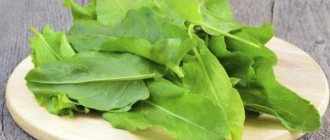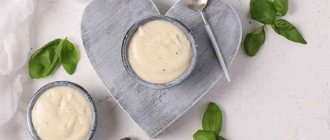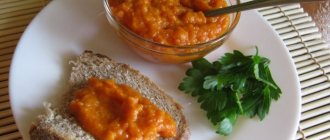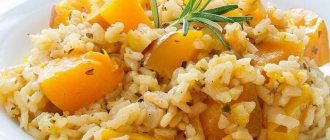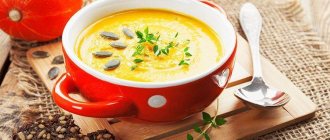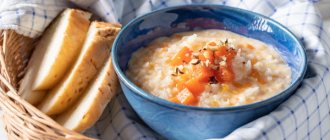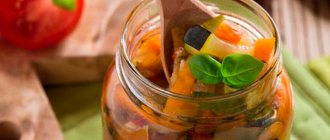Does pumpkin lose its beneficial properties when frozen?
If you follow the freezing technology, the beneficial properties of the vegetable will be preserved to the maximum extent possible. The loss of properties will be minimal: almost all vitamins, minerals, fiber and natural sugars will remain. Most dishes can be prepared with equal success from either fresh or frozen pumpkin.
Moreover, in the second case, the cooking process promises to become faster and generally easier, since the cutting of the pumpkin was done at the stage of preparation for freezing. The beneficial properties of the vegetable will help strengthen the immune system, lose excess weight, improve digestion, and normalize intestinal function.
The only downside to freezing is that the vegetable takes up space in the refrigerator. But nowadays almost all of them have large freezers. And some housewives even purchase a separate freezer for food preparations.
Basic rules for freezing pumpkin:
- choose ripe fruits without visible damage or defects;
- For storage, containers that can be tightly closed are used; vacuum bags are ideal;
- sometimes it is more useful to start cooking immediately from a frozen vegetable, without defrosting it.
Do not freeze thawed vegetables again. As a result of such an operation, the pumpkin will lose its taste, aroma and beneficial properties, and the re-thawed pieces will turn into a shapeless slurry.
Is frozen pumpkin healthy?
When frozen, all the beneficial components of the vegetable are completely preserved.
Did you know? The largest pumpkin pie was baked in the USA. Its diameter was 152 cm. The recipe included 3 kg of pumpkin, 1.5 kg of granulated sugar and 144 chicken eggs. The giant pie took 6 hours to bake.
Frozen pumpkin is in no way inferior to fresh pumpkin and has a number of health benefits:
- Due to its rich set of nutrients, it stimulates the immune system, fights cholesterol, and regulates metabolism.
- Slows down aging, normalizes sleep, improves hair condition and maintains a healthy complexion, increases overall energy and promotes a healthy body mass index (BMI).
- Indicated for people with diseases of the gallbladder, liver, kidneys, and urinary tract.
- Helps fight worms, removes excess water and salts from the body, promotes healing of wounds, cuts and other skin damage.
- The potassium contained in the vegetable regulates blood pressure. Thanks to this element, the risk of stroke is reduced and bone mineral density is preserved.
- Pumpkin is one of the most famous sources of beta-carotene. This powerful antioxidant reduces the risk of developing prostate and colon cancer, provides protection against asthma and heart disease,
- Antioxidants (vitamin C, E and beta-carotene) support eye health and prevent degenerative damage.
- Dietary fiber, which the orange fruit is rich in, regulates the gastrointestinal tract, helps digest food and reduces the risk of obesity. Fiber has a powerful effect on glucose absorption, slowing the rate at which sugar is absorbed into the blood. The vegetable not only prevents diabetes, but also helps control this disease.
How to prepare a vegetable for freezing?
You need to freeze pumpkin for the winter correctly; for this it is important to choose a fruit that is not yet overripe. Do not use pieces that have been in the refrigerator. It is better to give preference to whole fresh vegetables. You also need to make sure that the “tail” of the fruit is dry and free of rot.
The basis of preparation for freezing is cleaning and washing the vegetable:
- Wash the pumpkin thoroughly in running water. They even use special liquid soap for fruits and vegetables. But you can do without it.
- The vegetable is cut into pieces and the seeds and fibers are removed. It is convenient to use a tablespoon for this. Only the hard pulp is frozen.
- Remove the crust.
Subsequent steps taken for freezing depend on what dish the particular pumpkin preparation will be used for.
Video: how to freeze pumpkin for the winter in the freezer?
How to freeze pumpkin for the winter | Freezing vegetables at home
Watch this video on YouTube
Do you want to understand better than others?
- Is it possible to freeze sour cream and milk in the freezer for later consumption - Sour cream is one of the most favorite products, which is made from milk that has been processed in a certain way. But it is a perishable item and needs to be stored...
- Is it possible to freeze onions in the freezer: the best ways to prepare vegetables - Not only freshly picked green onions are prepared for future use, but also onions, despite the fact that they are quite successfully stored at home and do not spoil for a long time...
- Top 7 ways to freeze watermelon for the winter in the freezer - Watermelon is a large and ripe berry that evokes a pleasant association with summer warmth in adults and children. All winter you need to wait for the heat to come to please yourself with juicy pulp...
- How to properly freeze broccoli for the winter in the freezer - Broccoli is the closest relative of cauliflower; these vegetables benefit the human body and have approximately equal shelf life. You need to understand that the product is...
- How to freeze peaches for the winter: 8 best ways - Freezing will help you preserve a delicious piece of summer. Find out how to choose the right fruits for vitamin preparations, whether they can be stored in the refrigerator, what ways there are to...
Container and packaging
Containers play an important role during storage. Most often, they use what is at hand: plastic containers or bags. You can use any type of container that suits the size and method of freezing. You can freeze pumpkin for the winter in puree form; for this you can use an ice tray or plastic glasses. In the second case, it is convenient to place plastic film on the bottom of the glass before placing the puree. This will make it easier to remove the product after defrosting.
When packing into bags, it is most convenient to give the filled package a flat shape. This way it will take up less space, and the semi-finished product will be more convenient to dose.
The best option for packaging is vacuum bags. Their first advantage is that no extraneous aromas or air in general enter the product, so it stays fresh longer. Secondly, frozen vegetables take up little space in the freezer. Pumpkin is usually packaged in small portions. This way you can avoid defrosting and spoiling an excess amount of product.
How to properly freeze pumpkin
Table varieties of pumpkin are used for food. There is also a forage crop, it has the same bright pulp, but the taste leaves much to be desired. In addition, they contain less sugars. And after freezing the vegetable, their quantity will constantly fall. You can freeze pumpkin in a variety of ways. It all depends on the purposes for which it is subsequently intended to be used. And also from dishes in which pumpkin is supposed to be added in winter.
Sliced pumpkin is sometimes packaged together with other vegetables. For example, pumpkin is often added to carrots, zucchini and broccoli. This is done in order to obtain a complete dish, which only needs to be transferred to a baking or stewing dish. It is convenient to freeze components for vegetable stews or baby food this way.
Cubes
Most housewives prefer to freeze pumpkin in blocks. The size of the pieces may vary depending on the preferences of the individual.
Freezing instructions:
- The pumpkin is cleaned of seeds and peel. Cut into cubes.
- Take a board and cover it with cling film. If there is no film, you can wrap the board with a plastic bag or baking paper.
- Distribute the cubes evenly on the board and place the pumpkin in the freezer.
- Set the minimum temperature.
- After about 3.5 hours, the vegetable is taken out and poured into a container for permanent storage.
- Containers or bags are returned to the chamber for further freezing and storage.
How to freeze pumpkin for the winter - this can be done in cubes in a bag.
If you plan to use the pumpkin in soups, stewed vegetables or purees, you can get by with one freezing step. The cubes are immediately packaged and frozen. The individual parts will stick together, but if you add the lump to a hot dish immediately during cooking, it will crumble into cubes.
Shabby on a grater
You can freeze grated pumpkin for the winter to fill pancakes. The only important feature is that it is better to grate the vegetable on a coarse grater. Small pieces run the risk of turning into a shapeless mass when defrosting.
Freezing instructions:
- The peeled pumpkin bars are grated. A food processor works great for this.
- The resulting mass is packaged in bags in suitable portions.
- It is important to release the air from the bag and tie it well.
- Set the lowest temperature on the chamber.
- Place bags of pumpkin shavings in it.
There are very juicy varieties of vegetables. In this case, the semi-finished product must be squeezed out before packaging so that excess moisture becomes ice. But you shouldn't throw away the juice. It can be poured into ice or muffin molds. This is an excellent ingredient for beauty treatments or cocktails.
Using vacuum
In vacuum packaging, the product retains its taste and aroma longer, and therefore has a longer service life. You just need to get a special pump and bags.
Freezing instructions:
- Pieces or grated pumpkin are placed in special bags.
- Using a special vacuum pump, all the air is collected from the bags.
- Place in the freezer using the lowest temperature possible.
Having a special bag, you can remove the air from the pureed pumpkin with your hands, the main thing is to quickly tie it so that the air does not get inside again. For pieces you definitely need a vacuum sealer.
Purchasing a pump and bags requires additional material costs. But they justify themselves. Products placed in vacuum packaging last much longer and take up significantly less space in the freezer. Therefore, if you are thinking about purchasing an additional freezer, you may want to consider purchasing a vacuum pump and bags.
Cut up pumpkin
It is better to freeze the pumpkin for the winter before dark spots appear on its surface. In the refrigerator, pumpkin quickly deteriorates, and the large fruit is difficult to consume at one time.
Freezing instructions:
- The vegetable is cut into large pieces suitable in size for subsequent use in cooking.
- Wrap the parts with cling film in several layers.
- Place in the freezer and set the temperature to the lowest setting.
It's best not to freeze pumpkin that has only been divided into 3 or 4 pieces. Once thawed, the pumpkin will become softer and more watery. Therefore, stuffing it, most likely, will not work. It is more advisable to cut the vegetable into pieces that will then be convenient to use in cooking. Moreover, the peel can be left or peeled off.
Freeze as puree
Pumpkin frozen in puree form takes up much less space in the refrigerator than cut into pieces. Containers for puree can be plastic bags, ice cube trays, plastic glasses, and containers. It is better to place in a storage container such a volume of puree that will be optimal for one-time use. For baking, for example, 1 cup of puree is often used. You can also measure the required volume with a tablespoon.
Freezing instructions:
- Cut the pumpkin into approximately 2cm cubes.
- Boil in a saucepan.
- Crush in any convenient way.
- Place in storage containers and place in the freezer.
Frozen pumpkin puree is used to make pancakes, soups, pies, and is used in complementary feeding for children. In addition, pumpkin puree can help out if you don’t have eggs and really want to bake something.
How to Freeze Baked Pumpkin
Baking pumpkin is labor-intensive, but it allows you to get puree without extraneous liquid. In addition, this way, more of the beneficial properties of the vegetable will be preserved.
Baking instructions:
- Cut the vegetable into large pieces. Small vegetables can simply be divided into 2 parts.
- Do not remove the peel or seeds; they are very tasty when baked.
- Place skin side down on a baking sheet and place in an oven preheated to 180°C.
- Remove after 50-60 minutes.
- Grind the pumpkin to a puree consistency.
After the puree has cooled, it can be packed into storage containers and frozen.
Pros of freezing baked vegetables:
- the result is a full-fledged semi-finished product, which is cut ready for consumption;
- takes up little space in the refrigerator;
- significantly saves time during subsequent preparation of dishes.
Cons of freezing baked pumpkin:
- requires good packaging;
- loses a little in taste;
- has a short shelf life.
Boiled or baked pumpkin can be stored in the freezer for no more than 4 months. Moreover, it is better to consume it earlier, since every day the vegetable loses its taste, aroma and nutrients.
How to Freeze Blanched Pumpkin
You can freeze a vegetable such as pumpkin for the winter using preliminary blanching. This procedure will preserve the color and structure of the fibers of the fruit.
Freezing instructions:
- To boil water.
- Prepare a large container with ice water.
- Peel the pumpkin. Cut into small cubes. Place the chopped vegetable in a colander.
- Immerse the container in boiling water for a couple of minutes. Quickly transfer the colander to the ice water. Leave for 2-3 minutes.
- Dry the cubes on a paper towel or other convenient method.
- Transfer pumpkin to a tray. Place the pieces so that they do not touch each other.
- Place the pumpkin in the freezer for 2-3 hours.
- Place frozen cubes in bags or containers.
- Place the pumpkin in the freezer.
In order not to confuse blanched pumpkin with carrots in winter, storage containers must be labeled.
How to properly defrost before use
The defrosting process directly depends on the method of freezing and further use of the product. There are several ways :
- Thaw pumpkin puree in the refrigerator on the bottom shelf or in the microwave.
- To prepare porridges or stews, do not defrost them first. When frozen, it is placed in boiling water or milk, and then the rest of the ingredients are laid out.
- Grated pumpkin is also added without prior defrosting shortly before the end of cooking.
Important! Once thawed, a product cannot be re-frozen. Therefore, vegetables should be packaged in portions so that there is no excess left.
How long does pumpkin last in the freezer?
If your freezer has an instant freeze function, then you should definitely use it. The faster a vegetable freezes, the more beneficial properties it will retain, and the longer it will lose them during storage. By and large, pumpkin can be successfully stored in the freezer even for several years. Frozen vegetables, just like fresh ones, lose their beneficial properties. This happens more slowly, but the process is inevitable.
The specific timing depends on how you prepare the pumpkin for freezing. For example, at an average temperature in the freezer of about 15°C or lower, the vegetable will retain its properties for 12 months. But not baked and boiled.
This method of preparation significantly saves the housewife time in the winter, but reduces the shelf life by 3 times. Moreover, after thawing, the product is usually heated, which also negatively affects its nutritional quality. Therefore, the maximum shelf life of boiled pumpkin in the freezer is 4 months.
Is it possible and how to properly freeze pumpkin?
Pumpkin is not only a mandatory Halloween attribute, but also a healthy vegetable that contains many substances necessary for the human body.
Ascorbic acid, which is part of the vegetable, will boost immunity, rare vitamin T will help normalize digestion, prevent anemia, vitamin K will strengthen the skeletal system.
In addition, the orange vegetable is rich in vitamins A, D, E, F, PP, calcium, phosphorus, potassium, iron, fiber and plant sugars. Thanks to this, they try to preserve the pumpkin for the winter using various methods.
For example, they store it in the cellar, dry it, dry it, and even preserve it. Many people are interested in the question: is it possible to freeze pumpkin in the freezer? Of course, it is possible and even necessary. But we will describe in detail below how to properly freeze vegetables for the winter.
How to defrost vegetables correctly?
Before you defrost the pumpkin, you need to think about whether you need to do it at all. After all, frozen vegetables are added to a large number of dishes. Therefore, before freezing it is better to remove the skin. Pumpkin straight from the freezer is used in soups, purees, and stews. But when preparing the filling for baked goods, casseroles and dough, thawed pumpkin is used. This will require draining off excess water.
Instructions for properly defrosting pumpkin:
- Remove the product from the freezer.
- Place it in a container and put it in the refrigerator.
- Leave to defrost overnight or day.
- Drain off excess water.
Sometimes you even need to squeeze the moisture out of the vegetable. As a rule, this procedure is necessary when preparing pancakes or pancakes.
Frozen pumpkin soup
Frozen cubes make an excellent dish such as cream soup. It is prepared from vegetables with the addition of cream.
You will need:
- carrot;
- potato;
- onion;
- cream;
- seasonings to taste.
We recommend: Before trying lychee, find out about the benefits and contraindications
Preparation:
- Chop carrots, onions and potatoes and immerse in cold water.
- Throw in the frozen pumpkin pieces.
- Cook for about thirty minutes over medium heat.
- When the vegetables are cooked, grind them to a puree using a blender, at the same time add your favorite spices to taste.
- Lastly, add the cream and place the pan on the stove again.
- Bring to a boil and keep it there for 5 minutes.
This soup will be a great addition to the dinner table. It can be served with rye crackers and parsley or green onions.
Useful tips and tricks
To get the most out of pumpkin frozen in the refrigerator, you need to know a few nuances.
Useful tips will help you get a quality product:
- Only certain varieties can be frozen. Vegetables that have an elongated shape and bright orange flesh are best suited. Early pumpkin, light in color, does not tolerate high temperatures.
- It is better to choose a pumpkin that does not have defects on the skin. A vegetable that is rotting at sub-zero temperatures will continue to deteriorate.
- After harvesting, the pumpkin is left for a week at a temperature of 20-25°C. This allows you to remove excess moisture so that the vegetable can be preserved for a longer period.
- After defrosting, the pumpkin may be watery. To remove excess water, you can dry the vegetable in the oven or blanch it.
- It is better to store pumpkin frozen in the form of puree in bags, having first given them a flat shape. This way it will take up less space and will be easier to dose.
- The benefits of pumpkin increase when consumed in combination with fats. This way beta-carotene is better absorbed. You just need to add oil when preparing dishes, and not when freezing.
- To get rid of excess moisture when roasting the pumpkin, you can salt it. Leave it like this for a couple of hours. All that remains is to dry the vegetable.
- You cannot defrost pumpkin in warm water on a radiator. The vegetable will lose all its taste and benefits.
- Pumpkin seeds are not thrown away. This is a healthy treat. In addition, they are perfect as seed material in the spring.
- For subsequent preparation of puree used in complementary feeding of children under one year old, it is convenient to freeze the pumpkin in ice cube trays.
Frozen pumpkin perfectly retains its beneficial properties. For the winter it is left in the freezer. It is important to choose the right fruits and properly prepare them for freezing. There is nothing complicated about this; it is enough to know a few basic rules.


